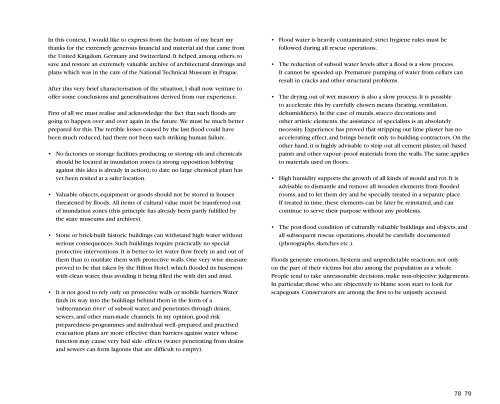Sicherheit und Katastrophenschutz für Museen, Archive
Sicherheit und Katastrophenschutz für Museen, Archive
Sicherheit und Katastrophenschutz für Museen, Archive
Sie wollen auch ein ePaper? Erhöhen Sie die Reichweite Ihrer Titel.
YUMPU macht aus Druck-PDFs automatisch weboptimierte ePaper, die Google liebt.
In this context, I would like to express from the bottom of my heart my<br />
thanks for the extremely generous financial and material aid that came from<br />
the United Kingdom, Germany and Switzerland. It helped, among others, to<br />
save and restore an extremely valuable archive of architectural drawings and<br />
plans which was in the care of the National Technical Museum in Prague.<br />
After this very brief characterisation of the situation, I shall now venture to<br />
offer some conclusions and generalisations derived from our experience.<br />
First of all we must realise and acknowledge the fact that such floods are<br />
going to happen over and over again in the future. We must be much better<br />
prepared for this. The terrible losses caused by the last flood could have<br />
been much reduced, had there not been such striking human failure.<br />
• No factories or storage facilities producing or storing oils and chemicals<br />
should be located in in<strong>und</strong>ation zones (a strong opposition lobbying<br />
against this idea is already in action); to date no large chemical plant has<br />
yet been resited at a safer location.<br />
• Valuable objects, equipment or goods should not be stored in houses<br />
threatened by floods. All items of cultural value must be transferred out<br />
of in<strong>und</strong>ation zones (this principle has already been partly fulfilled by<br />
the state museums and archives).<br />
• Stone or brick-built historic buildings can withstand high water without<br />
serious consequences. Such buildings require practically no special<br />
protective interventions. It is better to let water flow freely in and out of<br />
them than to mutilate them with protective walls. One very wise measure<br />
proved to be that taken by the Hilton Hotel, which flooded its basement<br />
with clean water, thus avoiding it being filled the with dirt and mud.<br />
• It is not good to rely only on protective walls or mobile barriers. Water<br />
finds its way into the buildings behind them in the form of a<br />
’subterranean river‘ of subsoil water, and penetrates through drains,<br />
sewers, and other man-made channels. In my opinion, good risk<br />
preparedness programmes and individual well-prepared and practised<br />
evacuation plans are more effective than barriers against water whose<br />
function may cause very bad side- effects (water penetrating from drains<br />
and sewers can form lagoons that are difficult to empty).<br />
• Flood water is heavily contaminated; strict hygiene rules must be<br />
followed during all rescue operations.<br />
• The reduction of subsoil water levels after a flood is a slow process.<br />
It cannot be speeded up. Premature pumping of water from cellars can<br />
result in cracks and other structural problems.<br />
• The drying out of wet masonry is also a slow process. It is possible<br />
to accelerate this by carefully chosen means (heating, ventilation,<br />
dehumidifiers). In the case of murals, stucco decorations and<br />
other artistic elements, the assistance of specialists is an absolutely<br />
necessity. Experience has proved that stripping out lime plaster has no<br />
accelerating effect, and brings benefit only to building contractors. On the<br />
other hand, it is highly advisable to strip out all cement plaster, oil-based<br />
paints and other vapour-proof materials from the walls. The same applies<br />
to materials used on floors.<br />
• High humidity supports the growth of all kinds of mould and rot. It is<br />
advisable to dismantle and remove all wooden elements from flooded<br />
rooms, and to let them dry and be specially treated in a separate place.<br />
If treated in time, these elements can be later be reinstated, and can<br />
continue to serve their purpose without any problems.<br />
• The post-flood condition of culturally valuable buildings and objects, and<br />
all subsequent rescue operations, should be carefully documented<br />
(photographs, sketches etc.).<br />
Floods generate emotions, hysteria and unpredictable reactions, not only<br />
on the part of their victims but also among the population as a whole.<br />
People tend to take unreasonable decisions, make non-objective judgements.<br />
In particular, those who are objectively to blame soon start to look for<br />
scapegoats. Conservators are among the first to be unjustly accused.<br />
78 79







